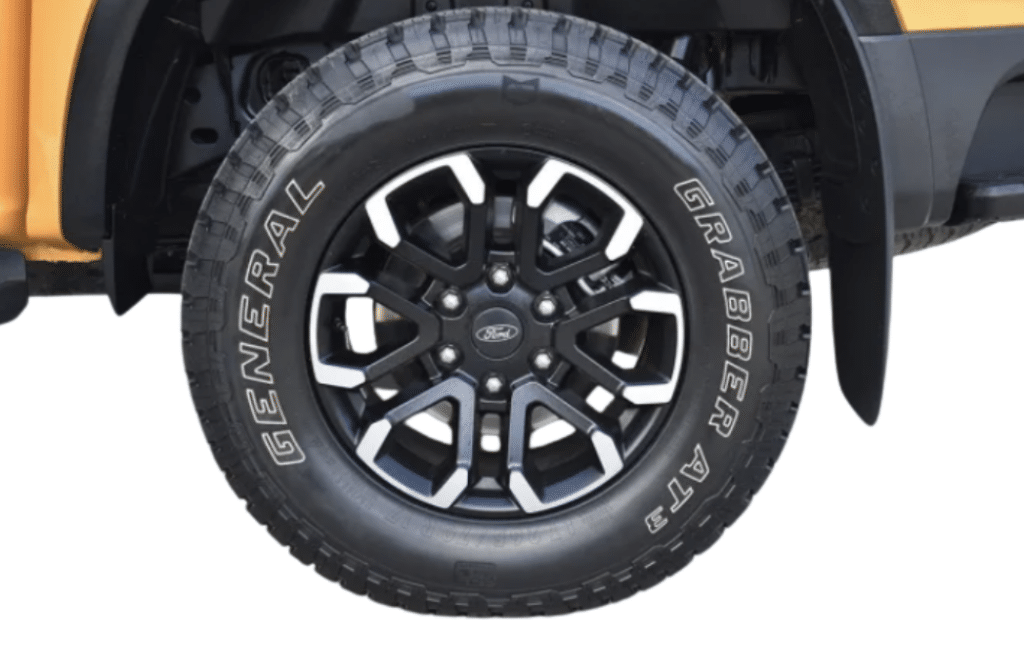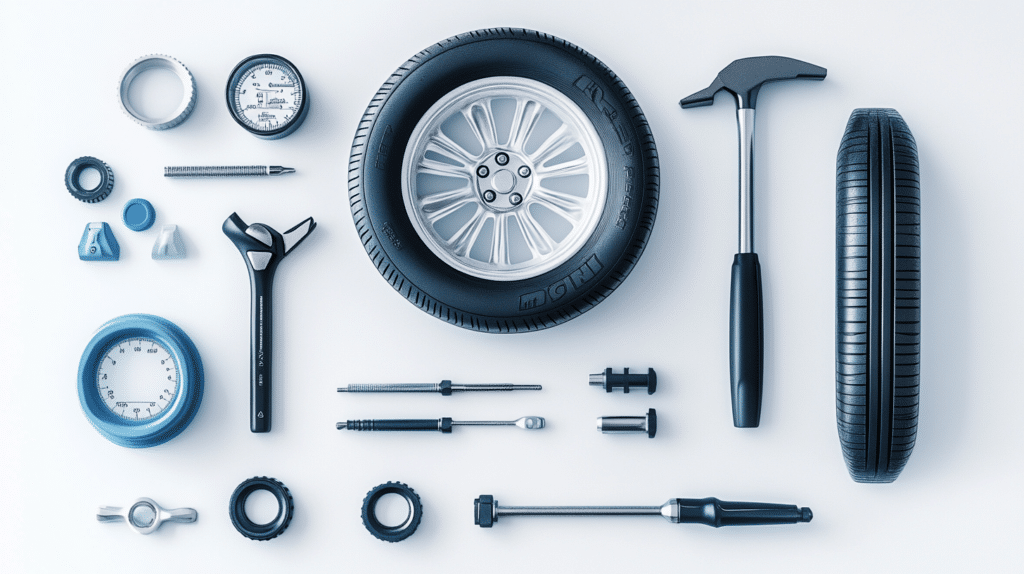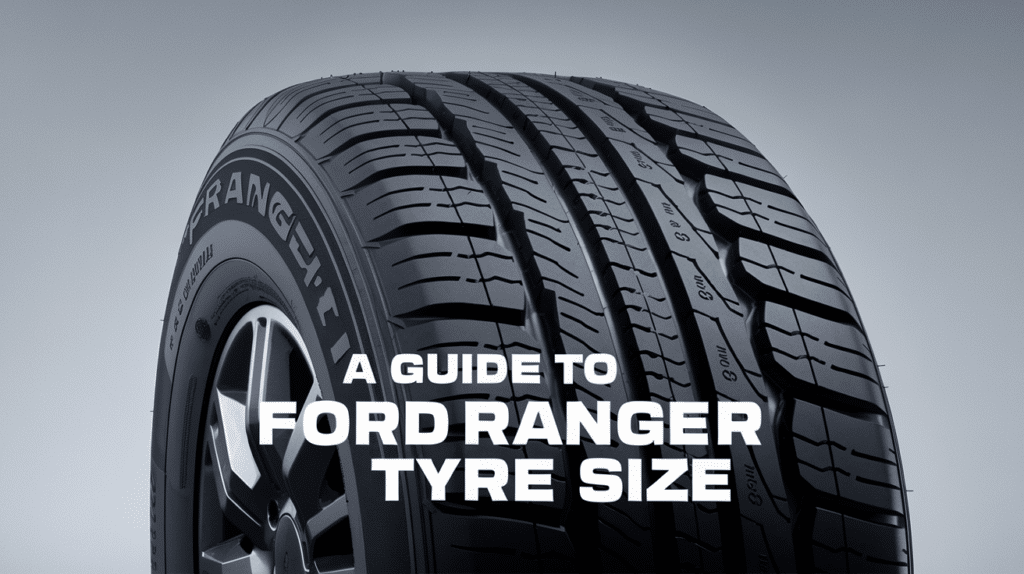Have you ever stood in front of your Ford Ranger, scratching your head about tire sizes?
Getting the wrong tire size can cost you money and put your safety at risk. I’ve seen many Ranger owners make costly mistakes because they didn’t understand tire specifications.
Trust me, I know how frustrating it feels to search through confusing numbers and letters on tire sidewalls.
But here’s the good news: I’m about to make tire sizing crystal clear for you. In this guide, I’ll break down Ford Ranger tire specs into simple bits.
By the time you finish reading, you’ll pick the right tires for your Ranger as easily as ordering your morning coffee.
Why Tyre Size Matters for Your Ford Ranger

Selecting the correct tyre size for your Ford Ranger is critical for maintaining optimal performance, safety, and longevity.
The importance of tyre size extends beyond aesthetics, influencing various aspects of your driving experience, including fuel efficiency, handling, and adaptability to different terrains.
Impact on Performance and Safety:
- Larger tyres improve off-road traction and stability, and they are ideal for rugged terrains.
- Smaller tyres offer better fuel efficiency and more agile handling for urban use.
Ensuring the size adheres to factory specifications or approved upgrades minimizes the risk of suspension interference, braking instability, and uneven tyre wear.
Adaptability to Terrain:
- All-Terrain (A/T) tyres provide versatility for mixed on-road and off-road use, often found in sizes like 265/65R17 or 265/60R18 for the Ranger.
- Mud-Terrain (M/T) tyres, available in larger sizes, are ideal for heavy off-road conditions.
Influence on Fuel Efficiency:
Tyres with a larger diameter, while offering increased ground clearance, tend to decrease fuel efficiency due to added rolling resistance.
For example: Switching from a standard 255/65R17 tyre to a larger 275/55R20 tyre increases the overall diameter, affecting the aerodynamic drag and fuel economy.
Legal and Warranty Considerations:
Incorrect tyre sizes may violate local regulations or void your vehicle’s warranty.
For example, exceeding the recommended rolling diameter or track width (as seen in modifications for wider offsets) can make your vehicle non-compliant with road laws.
Alignment with Vehicle Specifications:
The Ford Ranger supports a variety of tyre sizes tailored for specific trims:
- Standard Options: Factory-recommended sizes like 255/70R16 for base trims.
- Upgrades: Larger tyres like 285/70R17, suitable for vehicles with lift kits or intrusion beam replacements.
Choosing the right tyre size for your Ford Ranger enhances safety, optimizes performance, and ensures compliance with vehicle specifications and legal standards.
Understanding Tyre Size Notations

Tyre size notations can appear confusing at first, but they provide crucial information about your tyres’ dimensions and specifications.
A typical tyre size, such as 265/65R17, consists of three parts that describe the width, aspect ratio, and wheel diameter.
- Width (265): The width of the tyre in millimeters, measured from sidewall to sidewall.
- Aspect Ratio (65): The height of the sidewall as a percentage of the tyre’s width. For example, 65 means the height is 65% of the width.
- R (Radial): Indicates radial construction, the most common type of tyre design today.
- Wheel Diameter (17): The diameter of the wheel in inches that the tyre is designed to fit.
These markings are found on the sidewall of the tyre, along with additional details like load index and speed rating, helping you choose the right tyres for your Ford Ranger.
Standard Tyre Sizes for Ford Ranger Models
| Generation | Tyre Size | Rim Size | Tyre Type | Application |
|---|---|---|---|---|
| 2019–2023 (IV P375) | 255/70R16 | 16-inch | All-Season (A/S) | Base trims |
| 255/65R17 | 17-inch | All-Season (A/S) | Mid trims | |
| 265/65R17 | 17-inch | All-Terrain (A/T) | Off-road capable trims | |
| LT265/65R17 | 17-inch | Light Truck (A/T OWL) | Heavy-duty and towing | |
| 265/60R18 | 18-inch | All-Season (A/S) | High trims | |
| 275/55R20 | 20-inch | All-Season (A/S) | Premium trims | |
| 2022–2025 (V P703) | 255/70R16 | 16-inch | All-Season (A/S) | Entry/base trims |
| 255/70R17 | 17-inch | All-Season (A/S) | Standard trims | |
| 265/65R17 | 17-inch | All-Terrain (A/T) | Off-road capable trims | |
| LT285/70R17 | 17-inch | Light Truck (A/T OWL) | Off-road and heavy-duty | |
| 255/65R18 | 18-inch | All-Season (A/S) | High trims | |
| 255/60R19 | 19-inch | All-Season (A/S) | Premium trims | |
| 255/55R20 | 20-inch | All-Season (A/S) | Luxury/sports trims | |
| 37×12.50R17LT | 17-inch | Flotation (A/T) | Extreme off-road upgrades |
Factors to Consider when Choosing Ford Ranger Tyres
Selecting the right tyres for your Ford Ranger is essential to ensure optimal performance, safety, and comfort.
Below are the key factors you should keep in mind, broken down into practical categories.
1. Driving Conditions
The type of terrain and driving environment significantly influence your tyre choice.
- For highway driving, all-season tyres offer better efficiency and smoother rides.
- Off-road terrains demand all-terrain or mud-terrain tyres for improved grip.
- Consider weather-specific tyres for extreme conditions like snow or rain.
- Mixed-use tyres work well for drivers who frequently switch between city roads and rough paths.
2. Load Capacity
Your vehicle’s tyre load index determines how much weight each tyre can safely carry. Heavier loads require tyres with a higher load index for stability.
Light Truck (LT) tyres are better for towing or carrying equipment.
Ensure the tyres can handle the combined weight of the vehicle and its cargo.
3. Size and Fitment
Choosing the correct tyre size ensures compatibility with your Ford Ranger’s design.
- Follow manufacturer recommendations for size and fitment.
- Larger tyres improve off-road performance but can reduce fuel efficiency.
- Incorrect sizes may cause suspension interference or uneven tyre wear.
- Aftermarket upgrades should comply with legal guidelines to avoid issues.
- Consider ground clearance needs if planning off-road trips.
4. Weather Suitability
Weather plays a crucial role in tyre performance and longevity.
- All-season tyres are ideal for mild climates with moderate conditions.
- Winter tyres provide better traction in snow or icy roads.
- Summer tyres enhance performance during dry and hot weather.
- For year-round versatility, consider all-terrain tyres.
5. Budget and Brand Preference
Your budget and brand reliability can influence tyre selection.
Premium brands like Michelin or BFGoodrich offer superior performance and durability. Mid-range brands can balance cost and performance effectively.
Factor in long-term savings from higher-quality tyres with better mileage. Always ensure the brand adheres to safety and durability standards.
Evaluate warranty and customer reviews to choose the best option.
Ford Ranger VS Other Brands’ Tyre Size
| Brand/Model | Tyre Size | Rim Size | Price Range (Approx.) | Usage Type |
|---|---|---|---|---|
| Ford Ranger | 255/70R16 | 16-inch | $150–$200 | All-Season (Base) |
| Ford Ranger | 265/65R17 | 17-inch | $180–$250 | All-Terrain (Off-Road) |
| Toyota HiLux | 265/70R16 | 16-inch | $170–$220 | All-Season (Base) |
| Toyota HiLux | 275/65R18 | 18-inch | $200–$300 | All-Terrain (Premium) |
| Nissan Navara | 255/60R17 | 17-inch | $160–$220 | All-Terrain (Standard) |
| Nissan Navara | 265/60R18 | 18-inch | $200–$280 | All-Terrain (Luxury) |
| Isuzu D-Max | 245/70R16 | 16-inch | $140–$190 | All-Season (Base) |
| Isuzu D-Max | 275/55R20 | 20-inch | $220–$350 | All-Season (Premium) |
| Volkswagen Amarok | 245/65R17 | 17-inch | $170–$230 | All-Season (Standard) |
| Volkswagen Amarok | 265/60R18 | 18-inch | $200–$300 | All-Terrain (Premium) |
Tyre Maintenance Tips for Ford Ranger Owners

Proper tyre maintenance is essential to ensure your Ford Ranger delivers top performance and safety while extending the life of your tyres.
Here are some key tips:
- Check tyre pressure regularly to maintain optimal levels as recommended by the manufacturer.
- Inspect tyres for visible damage such as cuts, cracks, or bulges.
- Rotate tyres every 10,000–12,000 km to ensure even wear.
- Align wheels periodically to avoid uneven tyre wear.
- Balance tyres after installation or if you notice vibrations while driving.
- Monitor tread depth and replace tyres once they reach the legal limit.
- Avoid overloading your vehicle beyond the tyre’s load capacity.
- Clean tyres and remove debris stuck in the treads.
- Store spare tyres in a cool, dry place away from direct sunlight.
- Replace tyres promptly if they are older than five years, regardless of condition.
With these simple maintenance practices, you can enhance your Ford Ranger’s performance and ensure safe, smooth drives.
The Bottom Line
Picking the right tires for your Ford Ranger doesn’t need to be complex.
Throughout this guide, I’ve shown you how to read tire sizes, understand standard specifications, and compare options across different brands and prices.
Remember, tire size affects your Ranger’s performance, fuel use, and safety on the road.
I suggest starting with your owner’s manual to check the factory-recommended sizes. Then, use the sizing guide I shared to check your current tires.


